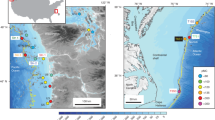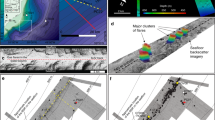Abstract
Abrupt periods of global warming between 57 and 50 million years ago—known as the Early Palaeogene hyperthermal events—were associated with the repeated injection of massive amounts of carbon into the atmosphere1,2,3,4. The release of methane from the sea floor following the dissociation of gas hydrates is often invoked as a source5. However, seafloor temperatures before the events were at least 4–7 °C higher than today1, which would have limited the area of sea floor suitable for hosting gas hydrates6,7. Palaeogene gas hydrate reservoirs may therefore not have been sufficient to provide a significant fraction of the carbon released. Here we use numerical simulations of gas hydrate accumulation8 at Palaeogene seafloor temperatures to show that near-present-day values of gas hydrates could have been hosted in the Palaeogene. Our simulations show that warmer temperatures during the Palaeogene would have enhanced the amount of organic carbon reaching the sea floor as well as the rate of methanogenesis. We find that under plausible temperature and pressure conditions, the abundance of gas hydrates would be similar or higher in the Palaeogene than at present. We conclude that methane hydrates could have been an important source of carbon during the Palaeogene hyperthermal events.
This is a preview of subscription content, access via your institution
Access options
Subscribe to this journal
Receive 12 print issues and online access
$259.00 per year
only $21.58 per issue
Buy this article
- Purchase on Springer Link
- Instant access to full article PDF
Prices may be subject to local taxes which are calculated during checkout



Similar content being viewed by others
References
Zachos, J. C., Dickens, G. R. & Zeebe, R. E. An early Cenozoic perspective on greenhouse warming and carbon-cycle dynamics. Nature 451, 279–283 (2008).
Lourens, L. J. et al. Astronomical pacing of late Palaeocene to early Eocene global warming events. Nature 435, 1083–1087 (2005).
Nicolo, M. J., Dickens, G. R., Hollis, C. J. & Zachos, J. C. Multiple early Eocene hyperthermals: Their sedimentary expression on the New Zealand continental margin and in the deep sea. Geology 35, 699–702 (2007).
Stap, L. et al. High-resolution deep-sea carbon and oxygen isotope records of Eocene thermal maximum 2 and H2. Geology 38, 607–610 (2010).
Dickens, G. R. Down the rabbit hole: Toward appropriate discussion of methane release from gas hydrate systems during the Paleocene–Eocene thermal maximum and other past hyperthermal events. Clim. Past 7, 1139–1174 (2011).
Dickens, G. R. Rethinking the global carbon cycle with a large, dynamic and microbially mediated gas hydrate capacitor. Earth Planet. Sci. Lett. 213, 169–182 (2003).
Dickens, G. R. The potential volume of oceanic methane hydrates with variable external conditions. Org. Geochem. 32, 1132–1193 (2001).
Bhatnagar, G., Chapman, W. G., Dickens, G. R., Dugan, B. & Hirasaki, G. J. Generalization of gas hydrate distribution and saturation in marine sediments by scaling of thermodynamic and transport processes. Am. J. Sci. 307, 861–900 (2007).
Tripati, A. & Elderfield, H. Deep-Sea temperature and circulation changes at the Paleocene–Eocene thermal maximum. Science 308, 1894–1898 (2005).
Sluijs, A. et al. Subtropical Arctic Ocean temperatures during the Palaeocene/Eocene thermal maximum. Nature 441, 610–613 (2006).
Thomas, D. J., Zachos, J. C., Bralower, T. J., Thomas, E. & Bohaty, S. Warming the fuel for the fire: Evidence for the thermal dissociation of methane hydrate during the Paleocene–Eocene thermal maximum. Geology 30, 1067–1070 (2002).
Sluijs, A. et al. Environmental precursors to rapid light carbon injection at the Palaeocene/Eocene boundary. Nature 450, 1218–1221 (2007).
Zeebe, R. E. & Zachos, J. C. Reversed deep-sea carbonate ion gradient during Paleocene–Eocene thermal maximum. Paleoceanography 22, PA3201 (2007).
Kvenvolden, K. A. Methane hydrate—a major reservoir of carbon in the shallow geosphere? Chem. Geol. 71, 41–51 (1988).
Zeebe, R. E., Zachos, J. C. & Dickens, G. R. Carbon dioxide forcing alone insufficient to explain Palaeocene–Eocene thermal maximum warming. Nature Geosci. 2, 576–580 (2009).
Milkov, A. V. Global estimates of hydrate-bound gas in marine sediments: how much is really out there? Earth Sci. Rev. 66, 183–197 (2004).
Buffett, B. & Archer, D. Global inventory of methane clathrate: Sensitivity to changes in the deep ocean. Earth Planet. Sci. Lett. 227, 185–199 (2004).
Pagani, M., Calderia, K., Archer, D. & Zachos, J. C. An ancient carbon mystery. Science 314, 1556–1557 (2006).
Davie, M. K. & Buffett, B. A. A numerical model for the formation of gas hydrate below the seafloor. J. Geophys. Res. 106, 497–514 (2001).
Garg, S. K., Pritchett, J. W., Katoh, A., Baba, K. & Fujii, T. A mathematical model for the formation and dissociation of methane hydrates in the marine environment. J. Geophys. Res. 113, B01201 (2008).
Paull, C. K. & Matsumoto, R. Leg 164 overview. Proc. ODP Sci. Res. 164, 3–10 (2000).
Weiss, R. F. The solubility of nitrogen, oxygen and argon in water and seawater. Deep-Sea Res. 17, 721–735 (1970).
Matear, R. J. & Hirst, A. C. Long-term changes in dissolved oxygen concentrations in the ocean caused by protracted global warming. Glob. Biogeochem. Cycles 17, 1125 (2003).
Archer, D. E., Morford, J. L. & Emerson, S. R. A model of suboxic sedimentary diagenesis suitable for automatic tuning and gridded global domains. Glob. Biogeochem. Cycles 16, 17.1–17.24 (2002).
Zeikus, J. G. & Winfrey, M. R. Temperature limitations of methanogenesis in aquatic sediments. Appl. Environ. Microbiol. 31, 99–107 (1976).
Price, P. B. & Sowers, T. Temperature dependence of metabolic rates for microbial growth, maintenance, and survival. Proc. Natl Acad. Sci. USA 101, 4631–4636 (2004).
Mikucki, J. A., Liu, Y., Delwiche, M. E., Colwell, F. S. & Boone, D. R. Isolation of a methanogen from deep marine sediments that contain methane hydrates, and description of Methanoculleus submarinus sp. nov. Appl. Environ. Microbiol. 69, 3311–3316 (2003).
Boone, D. R., Whitman, W. B. & Rouviere, P. in Methanogenesis: Ecology, Physiology, Biochemistry and Genetics (ed. Ferry, J. G.) 35–80 (Chapman Hall, 1993).
Acknowledgements
The authors thank the US Department of Energy for financial support (under Award No. DE-AC07-05ID14517 and No. DE-FC26-06NT42960).
Author information
Authors and Affiliations
Contributions
G.R.D. conceived the overarching hypothesis; G.B. constructed a prototype numerical model published elsewhere with insights from G.J.H, W.G.C. and G.R.D.; G.G. modified the model for this work, carried out the simulations and prepared the data, with advice and input from G.J.H, G.R.D. and W.G.C.; G.G. and G.R.D. wrote the initial manuscript; all authors contributed to subsequent revisions.
Corresponding authors
Ethics declarations
Competing interests
The authors declare no competing financial interests.
Supplementary information
Supplementary Information
Supplementary Information (PDF 543 kb)
Rights and permissions
About this article
Cite this article
Gu, G., Dickens, G., Bhatnagar, G. et al. Abundant Early Palaeogene marine gas hydrates despite warm deep-ocean temperatures. Nature Geosci 4, 848–851 (2011). https://doi.org/10.1038/ngeo1301
Received:
Accepted:
Published:
Issue Date:
DOI: https://doi.org/10.1038/ngeo1301
This article is cited by
-
The effect of temperature on organic carbon degradation in marine sediments
Scientific Reports (2015)



